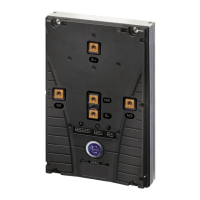PG DRIVES TECHNOLOGY AC TRACTION – MOTOR SET-UP EXAMPLE
1.8 Braking Percentage Levels
During Neutral Braking the controller will follow the motor set-up curve for voltage and slip. To increase or soften the Neutral
Braking over the whole range, set the parameter 1.10 Neutral Regen Braking level to a higher or lower percentage level of the
motor set-up. The same kind of adjustment is available for Footbrake and Direction Braking (1.11 & 1.9 respectively). The
Footbrake can operate in two ways, either with a switch and a fixed braking torque or proportional torque with a potentiometer.
1.9 Fine-tuning Drive
Now the basic set-up for nominal performance is finished, the vehicle can be tried carefully. First test the drive and brake
performance at low speed, then go in a few steps towards full speed testing both driving and braking. To prevent speeds that are
too high when testing, temporarily reduce the overall vehicle speed in both forward and reverse (1.4 & 1.5 respectively).
To get the right comfort feel, the voltage levels can be tweaked in small steps and tried out. Always check first at what frequency
the performance must be tuned, the status menu can be used to determine this frequency. Likewise, the motor set-up graph
can help to give a better feel for what kind of effect the motor setting change will have.
1.10 Additional Torque
If the vehicle needs to be tuned for more power at pull-off, block the motor and check the motor current. Increase the value of
the parameter 4.10 Drive Voltage Minimum in small steps until you reach the maximum current allowed for the motor or the
controller. Now you can increase the value of 4.14 Drive Slip Minimum. If the truck starts to lurch, the slip is too high and can be
reduced.
In this set-up the maximum unloaded speed of the vehicle on the flat is being optimized. The vehicle in this example has to drive
unloaded at 14kph and loaded with 1.5 tons at 13kph. With a gear ratio of 17,733:1 and a wheel radius of 28cm, the rotor
speed is 80Hz. We have to add the maximum slip to this speed (about 2 Hz slip) so we can set the maximum forward and reverse
speed to 82Hz. Drive the truck at full speed and check the programmer status menu 2.14 to see if the rotor speed reaches 80Hz.
80Hz is in between the base speed and the maximum speed setting. By increasing or decreasing the slip value for these 2 points
we can set more or less torque and current.
Now we can test the truck with load. Check if the speed reaches 13kph (74Hz). If not, change the slope from the slip curve so
that the truck drives 13kph with the lowest possible current. Maybe increase or decrease the base speed setting to have an
acceptable slope curve.
If this is O.K. the truck can be tested on a ramp. The specification for this truck is 8kph unloaded and 4 ~ 6kph with a load on a
15% ramp. This speed is between the Boost and Base Speed setting. By increasing the Boost Slip to 2.87Hz the truck was driving
with 8kph and the lowest current up the ramp. The loaded speed up the ramp is between Minimum and the Boost Speed. If the
torque is too low and increasing the slip is not enough, check the motor current. If the motor current is not at the maximum we
can decrease the Boost Speed setting, which will increase the motor current.
Changing speed points in the motor set-up will also affect the braking curve. After changing speed points carefully, retest the
braking performance.
1.11 The Results After Fine-tuning
We need more slip around the boost speed to have enough torque to go up the ramp. We can lower it around the base speed
and maximum speed because we don’t need the maximum torque but we want maximum efficiency at full speed. The
amended values and resulting plots on the graph are shown below.
• Motor Speed Minimum: 0Hz
• Motor Speed Boost: 30Hz
• Motor Speed Base: 70Hz
• Motor Speed Maximum: 125Hz
• Minimum Voltage: 0.6Vrms
• Drive Voltage Minimum: 3.8Vrms
• Drive Voltage Boost: 30.0Vrms
SK79646-01
1

